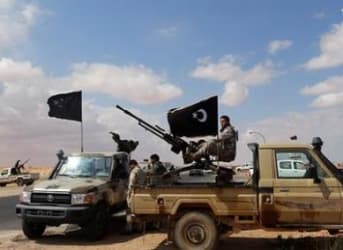As international attention shifts to the Islamic State, many observers have all but forgotten the link between the toppling of Libyan leader Muammar al-Qaddafi, and his one-party state, and the emergence of increasingly dangerous competition between tribal and Islamist factions in Libya.
In July, Tripoli’s airport was briefly shut down after a bomb blast, and Libya’s neighbours, Egypt and Tunisia, cancelled flights to airports in the country in August. The international response has been swift. Almost all the international organizations, NGOs and embassies evacuated their staff earlier this summer, while 150,000 of Libya’s foreign workers, largely from Bangladesh, Malaysia and the Philippines, continue to flee out of fear of further violence.
Related: Speculators May Rally to Crude After Nigeria and Libya Problems
“Libya is unable to protect its institutions, its airports and natural resources, especially the oil fields,” its ambassador to Egypt, Mohamed Jibril, said at a meeting with states in the region held in Cairo in August. Still, unlike in Iraq, Libya’s Islamists have been unable to secure control over Libya’s oil fields, far away from Tripoli in the Gulf of Sirte, at Libya’s largest and third-largest terminals for the export of oil, As-Sidr and Ras Lanuf (see map).

Figure 1: Libya’s largest and third-largest oil terminals are located at As-Sidr and Ras Lanuf in the Gulf of Sirte. Source: International Energy Agency.
However, Libya still lacks central control over its oil resources, which have become a bargaining chip in the competition for power over the country. Without steady income from its oil resources, observers predict that the government will be unable to maintain the high standard of living enjoyed by Libya’s citizens under Qaddafi.
Current GDP growth rate predictions for the fourth quarter of 2014 and into 2015 range from 15.3 to 22.4 percent.
Regional effects of the crisis
In Tunisia, mixed gains from the 2011 Arab uprisings have manifested in cautious democratic transition, but extremist groups could threaten the fragile gains made so far. Moreover, Tunisia’s government has faced problems generating private investment, effectively increasing the public deficit. In Egypt, President Abdel Fatah al-Sissi has almost entirely turned around the project of democratization promised by the uprisings in Tahrir Square in 2011.
In the medium-term, Libya’s fragile situation has both benefits and challenges for the region. The comparative risk of doing business in Libya means investors are likely to shift their attention to (the comparatively more stable) Tunisia and Egypt.
Related: Libya May Be Focus Of Major Rift Between US And Regional Allies
Still, strong regional trade ties mean these countries are very affected by the outcome of the Libyan conflict. A good example of this is a deal signed in June 2013 to provide Tunisia with a delivery of 650,000 barrels of crude oil and gas per month beginning in 2014, which is now threatened by the country’s internal instability.
The regional effects of the crisis have also been defined by the rise in oil production in Libya when compared with the civil war period. Confronted with a current global decline in oil prices, major oil producers like Saudi Arabia (Libya is the most significant oil producer in Africa, producing about 725,000 bb/day, an increase from just 300,000 bb/d in June 2014) have decided to reduce their oil production. In August, Saudi Arabia decreased its oil production by 408,000 bb/d to 9.86 million bb/d to offset the increase in production in Libya and the United States.
Prospects for the future
On September 6, Libya’s Islamist-dominated parliament swore in a government running in parallel to a newly-elected parliament sworn in June and based in Tobruk. The Islamist-dominated General National Congress (GNC) is not recognized by the international community.
However, several regional actors – including more-removed interested parties that have backed the militia of Gen. Khalifa Haftar, and the “Operation Dignity” movement targeting moderate and radical Islamist groups alike – have fomented a kind of Libyan proxy war.
The prospects for a regional recovery depend very much on the resolution of Libya’s significant problems having international implications.
By Amelie Meyer-Robinson
(Source: www.globalriskinsights.com)
More Top Reads From Oilprice.com:
- Renewed Violence In Iraq and Libya Could Send Oil Prices Up
- More Bad News for The Crude Oil Market
- Things Continue To Get Worse

















